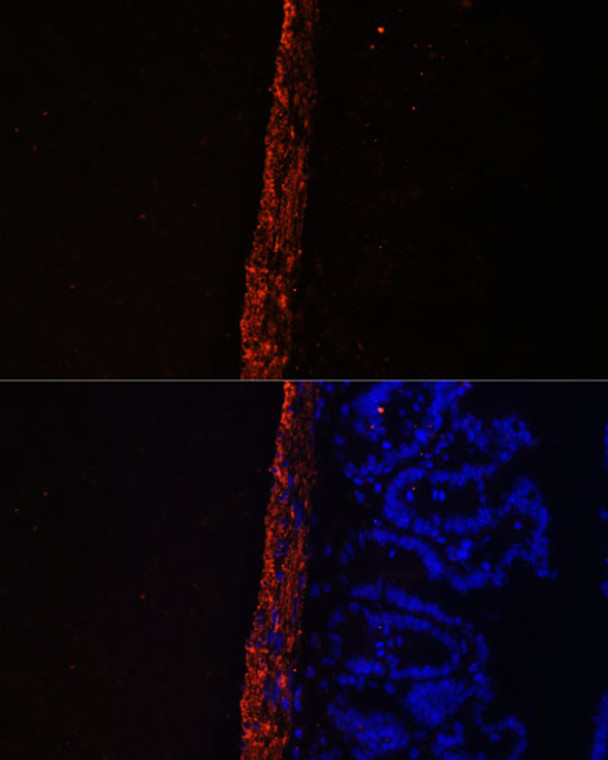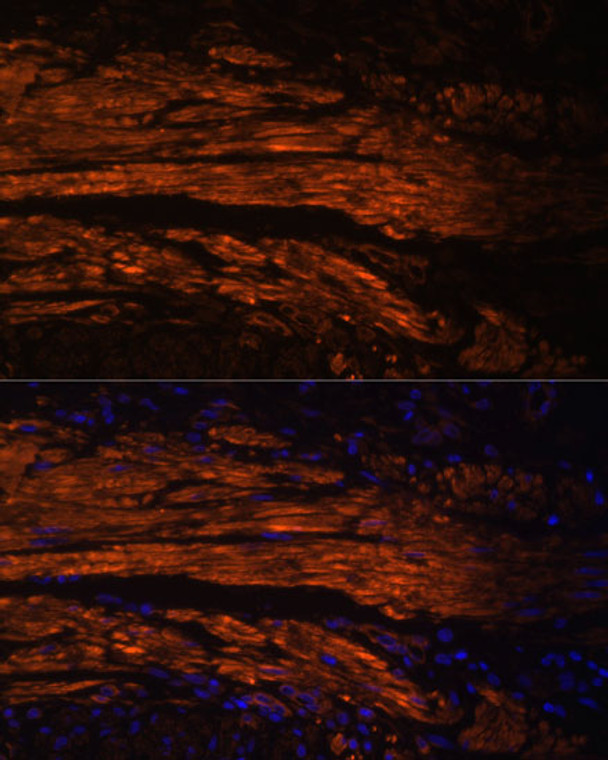| Host: |
Rabbit |
| Applications: |
WB/IF |
| Reactivity: |
Human/Mouse/Rat |
| Note: |
STRICTLY FOR FURTHER SCIENTIFIC RESEARCH USE ONLY (RUO). MUST NOT TO BE USED IN DIAGNOSTIC OR THERAPEUTIC APPLICATIONS. |
| Short Description: |
Rabbit polyclonal antibody anti-MYL9 (1-100) is suitable for use in Western Blot and Immunofluorescence research applications. |
| Clonality: |
Polyclonal |
| Conjugation: |
Unconjugated |
| Isotype: |
IgG |
| Formulation: |
PBS with 0.01% Thimerosal, 50% Glycerol, pH7.3. |
| Purification: |
Affinity purification |
| Dilution Range: |
WB 1:500-1:1000IF/ICC 1:50-1:200 |
| Storage Instruction: |
Store at-20°C for up to 1 year from the date of receipt, and avoid repeat freeze-thaw cycles. |
| Gene Symbol: |
MYL9 |
| Gene ID: |
10398 |
| Uniprot ID: |
MYL9_HUMAN |
| Immunogen Region: |
1-100 |
| Immunogen: |
A synthetic peptide corresponding to a sequence within amino acids 1-100 of human MYL9 (NP_006088.2). |
| Immunogen Sequence: |
MSSKRAKAKTTKKRPQRATS NVFAMFDQSQIQEFKEAFNM IDQNRDGFIDKEDLHDMLAS LGKNPTDEYLEGMMSEAPGP INFTMFLTMFGEKLNGTDPE |
| Tissue Specificity | Smooth muscle tissues and in some, but not all, nonmuscle cells. |
| Post Translational Modifications | Phosphorylation increases the actin-activated myosin ATPase activity and thereby regulates the contractile activity. It is required to generate the driving force in the migration of the cells but not necessary for localization of myosin-2 at the leading edge. Phosphorylation is required for myotube formation. |
| Function | Myosin regulatory subunit that plays an important role in regulation of both smooth muscle and nonmuscle cell contractile activity via its phosphorylation. Implicated in cytokinesis, receptor capping, and cell locomotion. In myoblasts, may regulate PIEZO1-dependent cortical actomyosin assembly involved in myotube formation. |
| Protein Name | Myosin Regulatory Light Polypeptide 920 Kda Myosin Light ChainLc20Mlc-2cMyosin RlcMyosin Regulatory Light Chain 2 - Smooth Muscle IsoformMyosin Regulatory Light Chain 9Myosin Regulatory Light Chain Mrlc1 |
| Database Links | Reactome: R-HSA-3928663Reactome: R-HSA-416572Reactome: R-HSA-445355Reactome: R-HSA-5625740Reactome: R-HSA-5625900Reactome: R-HSA-5627117Reactome: R-HSA-5627123Reactome: R-HSA-8936459 |
| Cellular Localisation | CytoplasmCytoskeletonCell CortexColocalizes With F-ActinMyh9 And Piezo1 At The Actomyosin Cortex In Myoblasts |
| Alternative Antibody Names | Anti-Myosin Regulatory Light Polypeptide 9 antibodyAnti-20 Kda Myosin Light Chain antibodyAnti-Lc20 antibodyAnti-Mlc-2c antibodyAnti-Myosin Rlc antibodyAnti-Myosin Regulatory Light Chain 2 - Smooth Muscle Isoform antibodyAnti-Myosin Regulatory Light Chain 9 antibodyAnti-Myosin Regulatory Light Chain Mrlc1 antibodyAnti-MYL9 antibodyAnti-MLC2 antibodyAnti-MRLC1 antibodyAnti-MYRL2 antibody |
Information sourced from Uniprot.org
12 months for antibodies. 6 months for ELISA Kits. Please see website T&Cs for further guidance










